Burial places of British royalty
These burial places of British royalty record the known graves of monarchs who have reigned in some part of the British Isles (currently includes only the monarchs of Scotland, England, native princes of Wales to 1283, or monarchs of the Great Britain, and the United Kingdom), as well as members of their royal families.
Monarchs of England (to 1603)
Pre-conquest
Post-conquest
| Name | Death | Place of burial | Images |
|---|---|---|---|
| William (I) the Conqueror | 1087 | Abbaye-aux-Hommes, Caen, Normandy | |
| William II (Rufus) | 1100 | Winchester Cathedral | 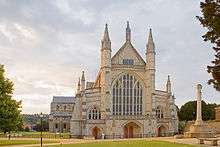 |
| Henry I | 1135 | Reading Abbey, Berkshire His remains were lost after the ruin of the Abbey.[1] |
|
| Stephen | 1154 | Faversham Abbey, Kent The abbey was demolished after the Reformation and Stephen's grave was destroyed. |  |
| Empress Matilda | 1167 | Rouen Cathedral, Normandy, France Remains transferred from Bec Abbey in Normandy. | 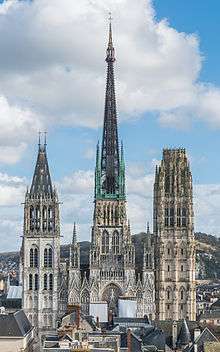 |
| Henry II | 1189 | Fontevraud Abbey, Anjou, France The grave no longer exists and was probably destroyed during the French Revolution. His effigy survives. | 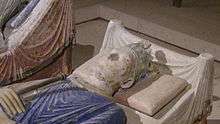 |
| Richard I | 1199 | Fontevraud Abbey, Anjou, France The grave no longer exists and was probably destroyed during the French Revolution. His effigy survives.
(His heart was buried at Rouen) |
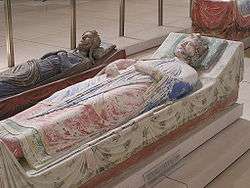 |
| John | 1216 | Worcester Cathedral |  |
| Henry III | 1272 | Edward the Confessor's Chapel, Westminster Abbey[2] |  |
| Edward I | 1307 | Edward the Confessor's Chapel, Westminster Abbey[3] | 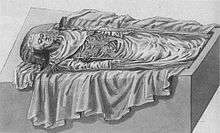 |
| Edward II | 1327 | Gloucester Cathedral |  |
| Edward III | 1377 | Edward the Confessor's Chapel, Westminster Abbey[3] |  |
| Richard II | 1400 | Edward the Confessor's Chapel, Westminster Abbey.[3] Remains transferred from Kings Langley church in Hertfordshire. | |
| Henry IV | 1413 | Canterbury Cathedral |  |
| Henry V | 1422 | Westminster Abbey | |
| Henry VI | 1471 | Windsor Castle (reburied in St George's Chapel 1484) | 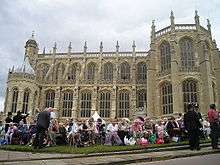 |
| Edward IV | 1483 | St George's Chapel at Windsor Castle | |
| Edward V | ?1483 | Traditionally believed to have been murdered and buried secretly in the Tower of London. Bones presumed to be his and those of his brother Richard, Duke of York were unearthed in the Tower in 1674 and re-buried in Westminster Abbey four years later. | |
| Richard III | 1485 | Leicester Cathedral. Originally buried across the street in Greyfriars, but the original tomb was lost when the friary was demolished in 1538. The remains of Richard III were recovered by an archaeological dig in 2012 and re-interred in 2015.[4] |  |
| Henry VII | 1509 | Henry VII Lady Chapel, Westminster Abbey[5] | |
| Henry VIII | 1547 | St George's Chapel at Windsor Castle | |
| Edward VI | 1553 | Henry VII Lady Chapel, Westminster Abbey | |
| Lady Jane Grey | 1554 | St Peter ad Vincula, Tower of London |  |
| Mary I | 1558 | Henry VII Lady Chapel, Westminster Abbey[5] | |
| Elizabeth I | 1603 | Henry VII Lady Chapel, Westminster Abbey[5] | _2013.jpg) |
Monarchs of Scotland (to 1603)
Native princes of Wales (to 1283)
| Name | Death | Place of burial | Image |
|---|---|---|---|
| Owain Gwynedd | 1170 | Bangor Cathedral | |
| Dafydd ab Owain Gwynedd (prince of north Wales only) | 1203 | England? | |
| The Lord Rhys (prince of south Wales only) | 1197 | St. David's Cathedral | |
| Llywelyn ab Iorwerth | 1240 | body interred at Aberconwy Abbey; later (apparently) removed to Maenan Abbey; sarcophagus now found at parish church of Llanrwst | |
| Dafydd ap Llywelyn | 1246 | body interred at Aberconwy Abbey; current whereabouts unknown | |
| Llywelyn ap Gruffudd | 1282 | Cwmhir Abbey | |
| Dafydd ap Gruffudd | 1283 | Hanged, drawn and quartered at Shrewsbury | |
Monarchs since 1603
(of England, and Scotland (1603–1707); of Great Britain (1707–1801); of United Kingdom (1801–present))
| Name | Death | Place of burial | Image | |
|---|---|---|---|---|
| James VI and I | 1625 | Henry VII Chapel, Westminster Abbey[5] | ||
| Charles I | 1649 | St George's Chapel, Windsor Castle |  |
|
- Interregnum. As Lords Protector the Cromwells served as heads of state and exercised monarchical power
| Name | Death | Place of burial | Image |
|---|---|---|---|
| Oliver Cromwell (Protector) | 1658 | Tyburn, London. Moved from Westminster Abbey in 1660 and dumped in a pit after posthumous execution. | |
| Richard Cromwell (Protector) | 1712 | Hursley Church, Hampshire | |
- Restored monarchy
| Name | Death | Place of burial | Image |
|---|---|---|---|
| Charles II | 1685 | Henry VII Chapel, Westminster Abbey[5] | |
| James II and VII | 1701 | Chapel of St Edmund, Church of the English Benedictines, Rue St. Jacques, Paris
(lost at the French Revolution)[22] |
|
| Mary II | 1694 | Henry VII Chapel, Westminster Abbey[5] | |
| William III and II | 1702 | Henry VII Chapel, Westminster Abbey[5] | |
| Anne | 1714 | Henry VII Chapel, Westminster Abbey[5] | |
| George I | 1727 | Chapel of Leine Castle in Hanover, Germany; moved from the crypt to the Welfenmausoleum at Herrenhausen on 5 December 1957.[23][24] |  |
| George II | 1760 | Henry VII Chapel, Westminster Abbey[5] | |
| George III | 1820 | St George's Chapel, Windsor Castle | |
| George IV | 1830 | St George's Chapel, Windsor Castle | |
| William IV | 1837 | St George's Chapel, Windsor Castle | |
| Victoria | 1901 | Frogmore, Windsor |  |
| Edward VII | 1910 | St George's Chapel, Windsor Castle | |
| George V | 1936 | St George's Chapel, Windsor Castle | |
| Edward VIII | 1972 | Royal burial ground at Frogmore, Windsor |  |
| George VI | 1952 | St George's Chapel, Windsor Castle |  |
Jacobite pretenders
| Name | Death | Place of burial | Image |
|---|---|---|---|
| James Stuart ("Old Pretender")
Charles Edward Stuart ("Bonnie Prince Charlie") |
1766
1788 1807 |
St. Peter's Basilica, Vatican (see also Monument to the Royal Stuarts) | 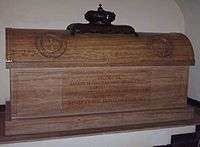
|
Other Royal burials (by place)
Sources
- Burial Places of the Kings & Queens of Britain britannia.com (Accessed 20 June 2007 - NB contains errors)
References and notes
- ↑ "A search for bones of Henry I is planned in Reading". BBC News. 24 March 2015. Retrieved 26 March 2015.
- ↑ Westminster Abbey Website (accessed 30 April 2015)
- 1 2 3 Westminster Abbey Website (accessed 30 April 2015)
- ↑ Burns, John F. (26 March 2015). "Richard III Gets a Kingly Burial, on Second Try". The New York Times.
- 1 2 3 4 5 6 7 8 9 Abbey Tour - The Lady Chapel Westminster Abbey website (accessed 20 June 2007)
- 1 2 Eochaid & Giric Undiscovered Scotland (accessed 20 June 2007)
- ↑ Findagrave.com (accessed 20 June 2007)
- ↑ Ross, David R (2003). Passion for Scotland. Dundurn. p. 37. ISBN 1842820192.
- ↑ Malcolm III Canmore Undiscovered Scotland (accessed 20 June 2007)
- ↑ EdgarUndiscovered Scotland (accessed 20 June 2007)
- ↑ David I Undiscovered Scotland (accessed 20 June 2007)
- ↑ Malcolm IV Undiscovered Scotland (accessed 20 June 2007)
- ↑ William I Undiscovered Scotland (accessed 20 June 2007)
- ↑ Alexander II Undiscovered Scotland (accessed 20 June 2007)
- ↑ John Balliol Undiscovered Scotland (accessed 20 June 2007)
- ↑ Robert II Undiscovered Scotland (accessed 20 June 2007)
- ↑ findagrave.com (accessed 20 June 2007)
- 1 2 Lundy, Darryl. "p. 10211". The Peerage. (accessed 20 June 2007)
- ↑ His queen – Jaon Beaufort – and Margaret Tudor (James IV's queen) are also buried there.find a grave.com (accessed 20 June 2007)
- ↑ James III Undiscovered Scotland (accessed 20 June 2007)
- ↑ James IVUndiscovered Scotland (accessed 20 June 2007)
- ↑ James' body was not actually buried - but remained in a coffin for a transfer to Westminster Abbey that never happened. His brain went the Scots College in Paris, his heart to the Convent of the Visitandine Nuns at Chaillot, and his bowels to the English Church of St. Omer and the parish church of St. Germain-en-Laye. All the body parts were lost during the French Revolution except the praecordia which as rediscovered in 1824 at the parish church of St. Germain-en-Laye, where it still remains. James II and VII, The Jacobite Heritage (accessed 20 June 2007)
- ↑ Helmut Knocke and Hugo Thielen (2007). Mausoleum, in: Dirk Böttcher, Klaus Mlynek (Eds.): Hannover Kunst- und Kultur-Lexikon. Handbuch und Stadtführer. Springe: zu Klampen Verlag. ISBN 978-3-934920-53-8 (p.92)
- ↑ Weir, Alison (1996). Britain's Royal Families: The Complete Genealogy, Revised edition. Random House. pp. 272–276. ISBN 0-7126-7448-9.
- ↑ Westminster Abbey Website (Accessed 1 December 2014)
This list is incomplete; you can help by expanding it.
This article is issued from Wikipedia - version of the 11/9/2016. The text is available under the Creative Commons Attribution/Share Alike but additional terms may apply for the media files.

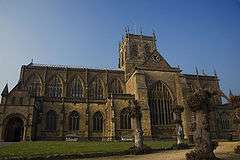


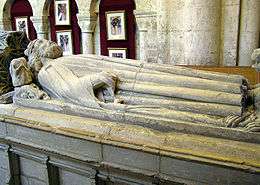


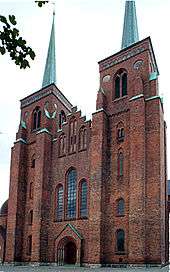


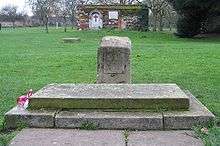
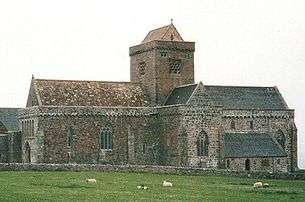
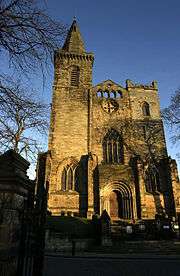





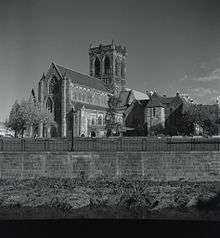

.jpg)

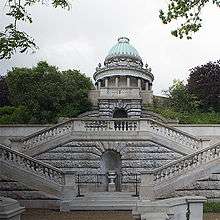


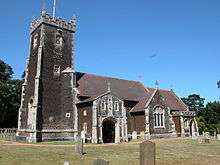
.jpg)

.jpg)




